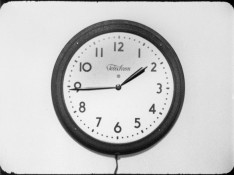Time as Material

Phi Phenomenon (Fisher, 1968)
Programmer Madison Brookshire in Person!
By the middle of last century, many artists stopped using their materials to represent something and instead focused in on the materials themselves: paint was only paint, metal only metal, etc. Likewise, artists working in cinema ceased trying to represent time and began to work with it directly. Through diverse means and subjects, each film in this program explores time as a material. From Andy Warhol’s slow cinema, at once luscious and austere, to the crystalline precision of Ernie Gehr’s formalism, this program of challenging and often surprisingly humorous works presents a new way of thinking about how cinema came to consider time itself.
Screening work by Andy Warhol, Richard Serra, Joyce Wieland, Morgan Fisher, Hollis Frampton, Coleen Fitzgibbon, Ernie Gehr, and more.
“Sensation, feelings, volitions, ideas—such are the changes into which my existence is divided and which colour it in turns. I change, then, without ceasing. But this is not saying enough. Change is far more radical than we are at first inclined to suppose.
“For I speak of each of my states as if they formed a block and were a separate whole. I say indeed that I change, but the change seems to me to reside in the passage from one stage to the next: of each state, taken separately, I am apt to think that it remains the same during all the time it prevails. Nevertheless, a slight effort of attention would reveal to me that there is no feeling, no idea, no volition, which is not undergoing change every moment: if a mental state ceased to vary, its duration would cease to flow. Let us take the most stable of internal states, the visual perception of a static object. The object may remain the same, I may look at it from the same side, at the same angle, in the same light; nevertheless the vision I now have of it differs from that which I have just had, even if only because the one is an instant older than the other. My memory is there, which conveys something of the past into the present. My mental state, as it advances on the road of time, is continually swelling with the duration it accumulates: it goes on increasing—rolling upon itself, as a snowball on the snow. … The truth is that we change without ceasing, and that the state itself is nothing but change.” –Henri Bergson, Creative Evolution
Los Angeles Filmforum at MOCA is supported through both organizations by the Los Angeles County Board of Supervisors through the Los Angeles County Arts Commission; the Department of Cultural Affairs, City of Los Angeles; and at MOCA by Catherine Opie.

Mario Banana Nos. 1 and 2
Directed by Andy Warhol (1964, 16mm, b/w, silent, 7 min.)
Simultaneously portraiture and performance, these films starring Mario Montez display Warhol’s superb color sense; gift for lush, over-exposed black and white photography; and economy in coaxing essentials of cinema—repetition, duration, desire, and memory—from seemingly effortless interventions. A simple sight gag becomes a tragicomic farce. –Madison Brookshire
Fluxfilm # 4, Disappearing Music for Face
Directed by Chieko Shiomi (1966, 16mm, b/w, sound, 11 min.)
Transition from smile to no-smile, shot at 2000fr/sec. Camera: Peter Moore. –George Maciunas
Sailboat
Directed by Joyce Wieland (1967, 16mm, color, sound, 3 min.)
A toy-like image of a sailboat sails, without interruption on the water, to the sound of roaring waves, which seem to underline the image to the point of exaggeration, somewhat in the way a child might draw a picture of water and write word-sounds on it to make it as emphatic as possible. –Robert Cowan, Take One
…it is time, “a little time in its pure state,” which rises up to the surface of the screen. Time ceases to be derived from the movement, it appears in itself. –Gilles Deleuze, Cinema 2
Hand Catching Lead
Directed by Richard Serra (1968, 16mm, b/w, silent, 3 min.)
Hand Lead Fulcrum
Directed by Richard Serra (1968, 16mm, b/w, silent. 3 min.)
I thought that if I was going to deal with some sort of filmic analogy [to constructing House of Cards] … that I could probably do that just by using my hands as a device. That, coupled with having seen Yvonne [Rainer]’s films and Warhol’s great freedom to pick up the camera the way he did, with the detachment that he had, made it seem possible, made it seem like something I could really entertain. –RS, interviewed by Annette Michelson, October

Phi Phenomenon
Directed by Morgan Fisher (1968, 16mm, b/w, silent, 11 min)
A single static close-up, bilaterally symmetrical about both axes, shows an ordinary electric classroom clock without a second hand running in regular fashion. –MF
Lemon
Directed by Hollis Frampton (1969, 16mm, color, silent, 7 min.)
A single static close-up, bilaterally symmetrical about both axes, shows an ordinary electric classroom clock without a second hand running in regular fashion. –MF
Wilkinson Household Fire Alarm
Directed by Morgan Fisher (1973, 16mm, color, sound, 1.5 min.)
Morgan Fisher has long explored the space that segregates art cinema from industrial movie making. The one-minute-thirty-second-long Wilkinson Household Fire Alarm, an eye-blink homage to Marcel Duchamp, is more obviously engaged with conceptualism than with studio manufacturing. What you see is what you hear. –Rotterdam International Film Festival
A Film of Their 1973 Spring Tour Commissioned by Christian World Liberation Front of Berkeley, CA
Directed by Owen Land (1974, 16mm, color, sound, 12 min.)
As an experience, it's mind-boggling. –Roger Ebert, Chicago Sun-Times
A document of what happened when a group of radical "Jesus Freaks" from Berkeley met conservative Christians in seminaries and colleges across the U.S. –Canadian Filmmakers Distribution Catalogue
Restoring the Appearance to Order in 12 min.
Directed by Coleen Fitzgibbon (1975, 16mm, color, sound, 10 min.)
As an experience, it's mind-boggling. –Roger Ebert, Chicago Sun-Times
A document of what happened when a group of radical "Jesus Freaks" from Berkeley met conservative Christians in seminaries and colleges across the U.S. –Canadian Filmmakers Distribution Catalogue
Untitled
Directed by Ernie Gehr (1977, 16mm, color, silent, 5 min.)
A simple, cinematic gesture illuminates an amount of space over a quantity of time and that their interdependence is both beautiful and sublime. –Madison Brookshire
If the state which ‘remains the same’ is more varied than we think, on the other hand the passing from one state to another resembles, more than we imagine, a single state being prolonged; the transition is continuous. –Henri Bergson, Creative Evolution
